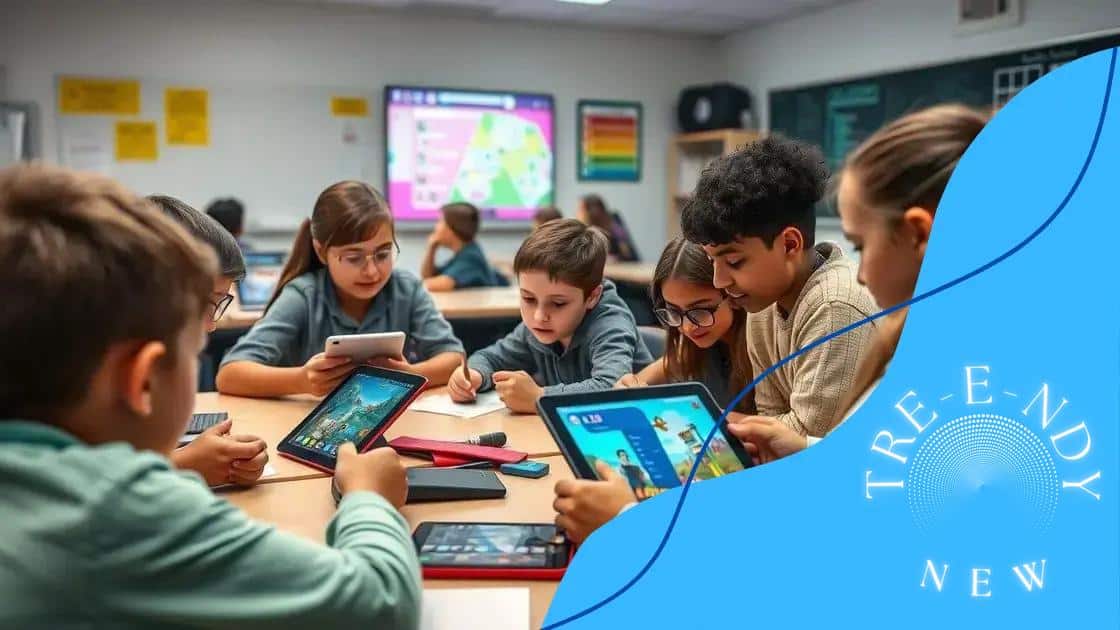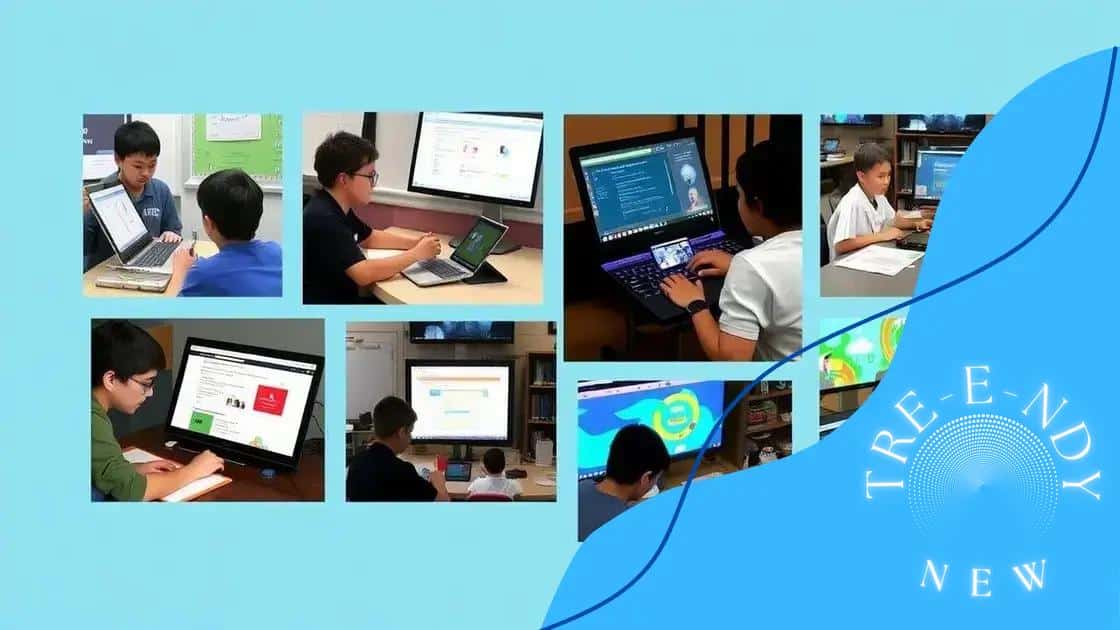Gamified educational content: engage your audience now

Gamified education enhances learning by incorporating game mechanics, improving student engagement, motivation, and retention through interactive tasks and rewards.
Gamified educational content has the potential to make learning not just informative, but also entertaining. Imagine transforming mundane lessons into interactive challenges that captivate learners. How does this approach change your perception of education?
Understanding gamified educational content
Understanding gamified educational content is essential for creating engaging learning experiences. This approach combines game elements with educational practices to motivate learners. By integrating fun and interactive features, educators can enhance the overall learning environment.
Key Components of Gamification
There are several key components that make up effective gamified content. These elements work together to ensure that students remain engaged and motivated.
- Points and Rewards: Students earn points for completing tasks, which can lead to rewards. This system encourages friendly competition.
- Levels and Progression: By introducing levels, learners feel a sense of achievement as they progress through challenges.
- Challenges and Quests: Incorporating tasks and missions keeps the learning process dynamic and exciting.
Moreover, feedback is vital in the gamification process. Providing instant feedback keeps learners informed of their progress. It allows them to reflect on what they have learned and what areas they need to improve.
When students receive immediate responses to their actions, they are more likely to engage with the content. This ensures that they stay motivated and continue learning actively. Incorporating storytelling can also enhance the experience, making lessons more relatable and enjoyable.
Benefits of Understanding Gamification
By grasping how to effectively implement gamified educational content, educators can reap numerous benefits. Some of these include:
- Improved Retention: Students remember information better when learning is fun and interactive.
- Increased Participation: Gamification encourages all students to participate, reducing disengagement.
- Collaboration: Many gamified activities promote teamwork and collaboration among students.
This dynamic approach to learning isn’t just about competition; it fosters collaboration and a sense of community among learners. By effectively understanding and using gamified educational content, educators can create a more inclusive and productive learning environment that benefits everyone.
Benefits of gamification in learning
The benefits of gamification in learning are numerous and impactful. By integrating game-like elements into educational practices, educators can create more engaging and effective learning experiences for students.
Enhanced Engagement
One major advantage is enhanced engagement. When students are challenged with interactive tasks, they become more invested in their learning. The excitement of earning rewards or reaching new levels keeps their interest alive.
- Increased Motivation: Gamification provides intrinsic motivation through rewards and recognition.
- Active Participation: Students are more likely to participate actively in gamified lessons.
- Fun Learning Environment: Learning becomes enjoyable, reducing anxiety often associated with traditional methods.
Additionally, gamification fosters a sense of achievement. As students accomplish tasks, they experience a boost in self-esteem. This positive feedback loop encourages them to take on more challenges, reinforcing their commitment to learning.
Another significant benefit is improved retention. Research shows that learners remember information better when it is delivered in a fun and interactive format. This retention is crucial as students need to grasp complex concepts in various subjects.
Skill Development
By implementing gamified education, students also develop essential skills. These include problem-solving, critical thinking, and collaboration. Gamified activities often require teamwork and communication, preparing students for future scenarios.
- Collaboration Skills: Working together on tasks helps students learn the value of teamwork.
- Critical Thinking: Gamification often presents problems that promote analytical thinking.
- Time Management: Students learn to manage their time efficiently while racing against the clock in games.
Incorporating these elements into educational systems doesn’t just prepare students academically; it also equips them with life skills that are crucial for success in and out of the classroom. Overall, the implementation of gamification in learning leads to a richer, more adaptive educational experience.
Practical examples of gamified content

Practical examples of gamified content can illustrate how this approach enhances learning. By seeing real applications, educators can better understand its potential.
Interactive Quests
One effective method is using interactive quests. Students embark on missions that require them to solve problems or complete tasks. These quests can be designed around various subjects, like math or science, where each task they complete earns them rewards.
- Math Adventures: Students solve math problems to unlock new levels in a journey through a fantasy world.
- Science Missions: Learners conduct virtual experiments to advance in a storyline.
- Literature Challenges: Completing reading assignments can lead to critical plot points in an ongoing story.
Moreover, using leaderboards adds a competitive edge that motivates students. Seeing their progress compared to their peers encourages them to strive for improvement.
Game-Based Platforms
Another practical example is utilizing game-based learning platforms. These platforms provide structured environments where students can learn through games designed specifically for educational purposes.
- Kahoot: A fun quiz platform that lets teachers create interactive quizzes; students compete in real-time.
- Classcraft: This platform promotes positive behavior and collaboration through role-playing game mechanics.
- Prodigy: A math game that adapts questions based on student skill levels, keeping them engaged and challenged.
Furthermore, many educators incorporate storytelling into their gamified content. By weaving narratives into lessons, students can connect emotionally with the material. Engaging stories can make complex concepts feel relatable and memorable.
Ultimately, these practical examples of gamified content show how integrating game elements can create a vibrant learning environment. By actively participating in their education, students develop a deeper understanding and greater retention of the subjects being taught.
How to create effective gamified experiences
Creating effective gamified experiences involves several key steps. Educators and designers need to combine engaging elements with clear learning objectives to ensure success.
Define Goals
Start by defining clear educational goals. What do you want students to learn? These objectives will guide the gamification process and ensure the content remains focused and effective.
- Learning Outcomes: Establish specific skills or knowledge students should acquire.
- Engagement Metrics: Decide how you will measure student engagement and progress.
- Feedback Mechanisms: Determine how and when feedback will be given to students.
Once the goals are clear, the next step is to design the gamification elements. Integrating game mechanics will enhance the learning experience.
Incorporate Game Mechanics
Consider adding various game mechanics to make the learning process enjoyable. Points, badges, and leaderboards are great tools to motivate students.
- Points: Reward students with points for completing tasks and achieving milestones.
- Badges: Create badges for specific achievements to recognize student efforts.
- Leaderboards: Use leaderboards to foster competition and encourage students to improve.
Integrating storytelling into gamified experiences can also elevate engagement. A compelling story can captivate students’ attention, making the material more relatable and easier to understand.
After designing the mechanics, testing your gamified activities is vital. Gather feedback from students and make necessary adjustments. This iterative process ensures that the gamified content is effective and meets the desired educational outcomes.
Develop a Supportive Environment
Finally, creating a supportive learning environment is essential for gamified experiences. Encourage collaboration among students and promote a sense of community. When students feel supported, they are more likely to engage actively with the content.
In summary, by setting clear goals, incorporating engaging game mechanics, and fostering a supportive atmosphere, educators can create truly effective gamified experiences that enhance learning and motivate students.
Measuring success in gamified education
Measuring success in gamified education is crucial for determining the effectiveness of these innovative approaches. Educators need to assess both engagement and learning outcomes to ensure students are benefiting from gamification.
Engagement Metrics
One of the first steps is to establish engagement metrics. This can involve tracking how often students participate in gamified activities and how well they perform. For instance, educators can monitor:
- Participation Rates: Track how many students are actively participating in gamified lessons.
- Completion Rates: Measure the percentage of tasks completed within the game setting.
- Time Spent: Analyze how much time students spend engaging with the gamified content.
By collecting data on these metrics, teachers can identify trends and patterns in student behavior, allowing for adjustments to enhance engagement.
Learning Outcomes
Another important aspect is evaluating learning outcomes. It is essential to assess whether gamification leads to effective knowledge retention. Educators can use various methods to measure this:
- Quizzes and Tests: Implement assessments before and after the gamified experience to compare performance.
- Feedback Surveys: Collect feedback from students about what they learned and how they felt about the gamified activities.
- Skill Assessments: Evaluate students’ skills related to the content learned through gamification.
Regularly analyzing learning outcomes provides insights into how well the gamified approach is working and what areas may need improvement.
Combining engagement metrics with learning outcomes creates a holistic view of success in gamified education. Educators can make informed decisions about continuing, modifying, or expanding their gamification efforts based on these data-driven insights.
In conclusion, gamification has the potential to transform education by making learning more engaging and enjoyable. By incorporating game mechanics, educators can enhance participation and motivation among students. Understanding how to create effective gamified experiences and measuring their success are critical steps in this process. As we continue to explore and implement gamification in educational settings, we can help students develop important skills while making learning fun.
FAQ – Frequently Asked Questions about Gamified Education
What is gamified education?
Gamified education uses game mechanics to enhance learning experiences, making them more engaging and fun for students.
How can I measure the success of gamified learning?
You can measure success by tracking student engagement metrics, completion rates, and learning outcomes through assessments and feedback.
What are some examples of gamified content?
Examples include interactive quests, educational games, quizzes on platforms like Kahoot, and earning badges for achievements.
How do game mechanics benefit students?
Game mechanics, like points and leaderboards, motivate students by providing clear goals, fostering competition, and rewarding achievements.





